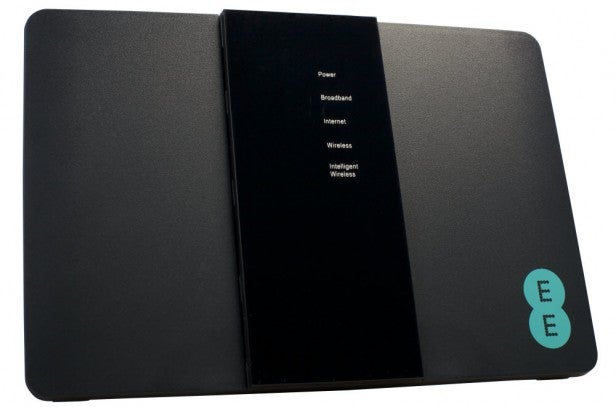EE Bright Box 2 802.11ac router Review - Performance & Verdict Review
Performance & Verdict
The first ISP supplied 802.11ac router also has a VDSL modem

Sections
- Page 1 EE Bright Box 2 802.11ac router Review
- Page 2 Performance & Verdict Review
EE Bright Box 2 – Performance
So do we finally have an ISP router to compete with the big boys? Yes and no. The ‘yes’ comes from its performance at shorter distances where it excels, but unfortunately the ‘no’ results from significant speed drops at long range caused by the 2×2 antenna array.
 802.11ac results are a perfect illustration of this. At 2m and 10m line of sight, the Bright Box 2 managed 47.1MBps (376.8Mbps) and 43.6MBps and (348.8Mbps), scores which put it right up there with the fastest wireless ac routers we have tested – including current industry benchmark the Asus RT-AC68U.
802.11ac results are a perfect illustration of this. At 2m and 10m line of sight, the Bright Box 2 managed 47.1MBps (376.8Mbps) and 43.6MBps and (348.8Mbps), scores which put it right up there with the fastest wireless ac routers we have tested – including current industry benchmark the Asus RT-AC68U.
Unfortunately at 13m behind two standing walls Bright Box 2 wireless ac collapses to just 10.9MBps (87.2Mbps). This is one of the slowest 802.11ac results we’ve had, behind even some 802.11n 5GHz speeds at this test point.
By contrast the best routers we’ve seen such as the aforementioned AC68U and Linksys EA6700 are within a whisker of 30MBps. In fact even the similarly 2×2 RT-AC56U manages 16.4MBps (131.2Mbps), though it does stress the problem.
Happily the trend does break at 802.11n 5GHz (graphs in the gallery) where the Bright Box 2 provided the fastest speeds we’ve seen so far at both 2m and 10m. It hit 25.2MBps (201.6Mbps) and 25.7MBps (205.6Mbps) with an actual increase at 10m showing this range had no impact at all.
At 13m there was a drop off, but 9.72MBps (77.76Mbps) is still reasonable and keeps it near the top bracket with only the standout performance of the AC68U (16.9MBps) leaving it significantly behind.
Sadly the range problems were back for our 802.11n 2.4GHz results though and here the Bright Box 2 was a real let down (graphs again in the gallery). At 2m speeds of 9MBps (72Mbps) are sluggish but acceptable, though at 10m and 13m it collapsed to just 3.39MBps (27.12Mbps) and 2.38MBps (19.04Mbps).
The former is 3x slower than most third party wireless ac-equipped rivals and the latter is half the speed. We have seen cheaper wireless ac routers struggle with range and 2.4GHz performance before and with legacy equipment still reliant on the standard it is a poor corner to cut.
 Lastly USB network performance was an unremarkable 5.97MBps (47.76Mbps) just as recent routers have begun to break away and hit 15-20MBps. Furthermore 5.97MBps is misleading given how variable the performance was during the test. With lows closer to 2MBps you would struggle to reliably stream HD video from USB attached storage.
Lastly USB network performance was an unremarkable 5.97MBps (47.76Mbps) just as recent routers have begun to break away and hit 15-20MBps. Furthermore 5.97MBps is misleading given how variable the performance was during the test. With lows closer to 2MBps you would struggle to reliably stream HD video from USB attached storage.

Should I buy the EE Bright Box 2?
The answer depends entirely if you have to ‘buy’ it. For new customers and existing customers prepared to sign a new 18 month contract you will get the Bright Box 2 free. In this scenario a single box solution with peak speeds that leave its 802.11n ISP-supplied rivals in the dirt the answer is a no brainer.
That said, upgrade in contract and EE values the Bright Box 2 at a hefty £175. Given it integrates a VDSL2 modem this is not extortionate, but unless you’re obsessed with having a single box solution we’d rather spend an extra £15 on the much more powerful 3×3 array Asus RT-AC68U. If you want to save some money the Linksys EA6700 (£169.99), Asus RT-AC66U (£159.99) and D-Link DIR-868L (£139.99) are all cheaper 3×3 array alternatives with far better performance at distance.
Head to our best routers round-up for the all the best alternatives.
Verdict
EE deserves a great deal of credit for being the first ISP to supply an 802.11ac compliant router and even greater credit for integrating it with a VDSL2 modem. It looks good, short range performance is blistering and new and upgrading customers can get it for free. It flounders at long range, but if you can get it for free, do it.
Trusted Score
Score in detail
-
Performance 7
-
Value 8
-
Features 7
-
Build Quality 7
-
Usability 7

